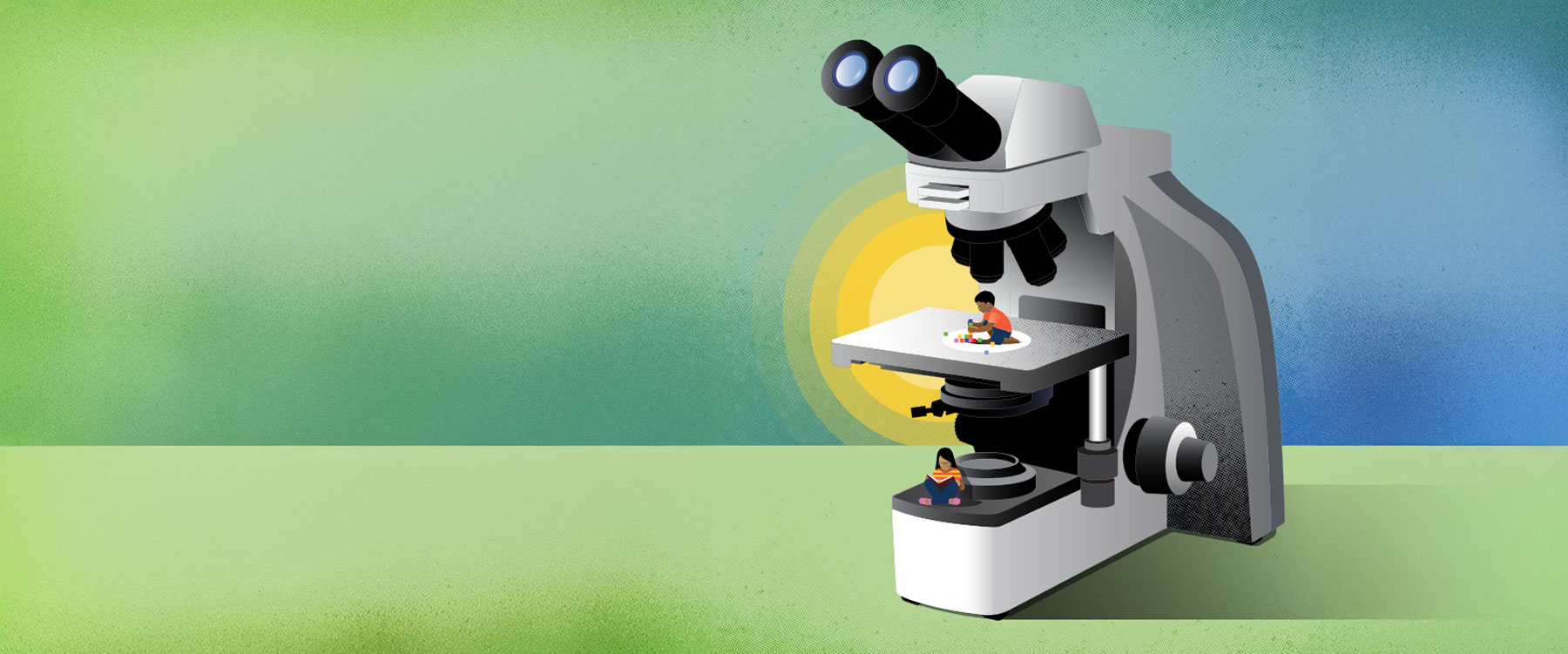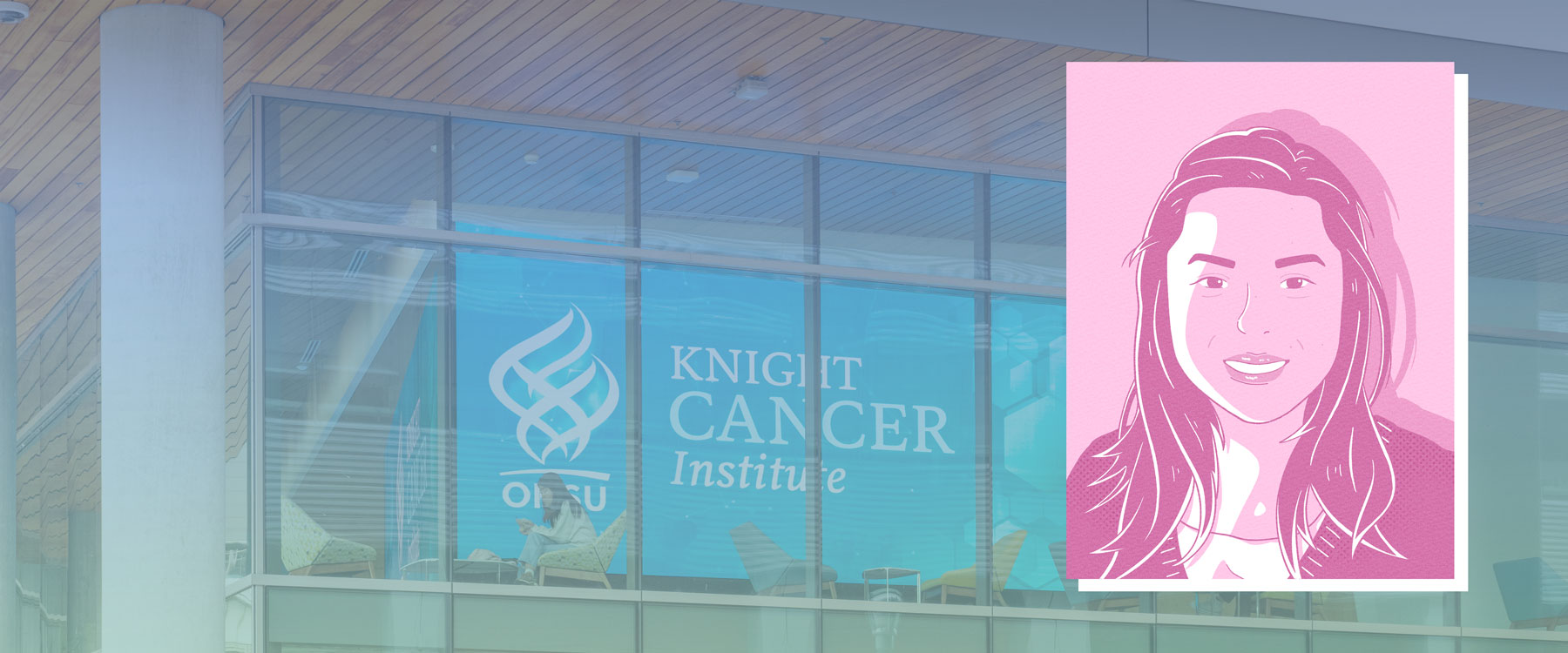On May 1, OHSU Research Week kicked off with poster sessions in the BICC Library. Presentations from 146 researchers, students, graduate students and doctoral candidates covered topics from biochemistry to pediatric psychology. We asked eight of these presenters to break down their breakthroughs into plain language. Take a listen below to hear how OHSU is discovering and innovating the future of health care.
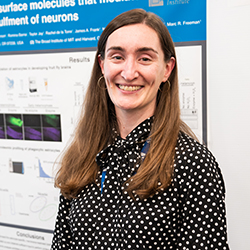
Leire Abalde-Atristain, Ph.D.
Postdoctoral Fellow
OHSU Vollum Institute
Title of research: “Profile of glial cell-surface molecules that mediate the engulfment of neurons”
Co-authors: Yunsik Kang, Charles Xu, Katherine Lehmann, Amanda Jefferson, Romina Barria, Taylor Jay, Rachel de la Torre, Namrata D. Udeshi, Steven A. Carr, Marc R. Freeman
Transcript
My name is Leire Abalde-Atristain. My work is entitled “Profile of glial cell-surface molecules that mediate the engulfment of neurons.” What I’m trying to understand is how the nervous system develops and maintains itself healthy as we age. Specifically, I want to understand when a neuron dies, or a part of a neuron is no longer needed, how other cells deal with it. I am hoping that, resulting from my research, I will be able to better understand how the neurons can be removed before they can cause damage. And this will help people with developmental disorders, such as autism, but also people suffering from neurodegenerative diseases, as well as veterans who have undergone trauma to the head in combat.
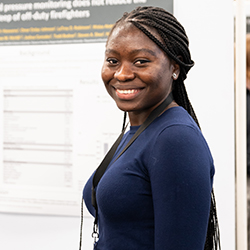
Aanu Ayeni, M.P.H.
Research Assistant
Oregon Institute of Occupational Health Sciences at OHSU
Title of research: “Ambulatory blood pressure monitoring does not reduce the sleep of off-duty firefighters”
Principal Investigator: Nicole Bowles, Ph.D.
Co-authors: Ayeisha H. Haswarey, Omar Ordaz-Johnson, LaTroy D. Robinson, Walaa Abdelmoaty, Maya X. Herzig, David Hurtado, Andrew W. McHill, Joshua Gonzalez, Todd Bodner, Steven A. Shea, Nicole P. Bowles
Transcript
My name is Aanu Ayeni. The title of my research is “Ambulatory blood pressure monitoring does not reduce the sleep of off-duty firefighters.” The gold standard to assess whether you have hypertension is to wear a blood pressure cuff for 24 to 48 hours. But, that means you will wear this while you are sleeping. Firefighters, like many other shift workers, need to sleep when they’re not working so they can be refreshed when they actually have to work. We were, essentially, just making sure that when they do have to check their blood pressure, their sleep is not impacted.
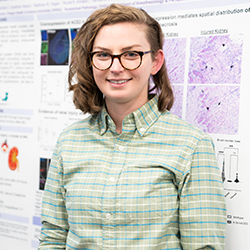
Jacqueline Emathinger
M.D./Ph.D. Program student
Division of Nephrology and Hypertension, OHSU
Title of research: “ACE2 overexpression mediates spatial distribution of pathologic features in acute kidney injury”
Principal Investigator: Michael Hutchens, M.D., M.A.
Co-authors: Joshua A. Robertson, Jonathan W. Nelson, Matthew W. Hagen, Nicole K. Andeen, Vanderlene L. Kung
Transcript
Hi. My name is Jacqueline Emathinger. I am presenting a poster called “ACE2 overexpression mediates spatial distribution of pathologic features in acute kidney injury.” Acute kidney injury is a really big problem in hospitalized patients. There is a sudden loss of kidney function. And so, the hope of my work is to help promote recovery after injury of your kidney. And so, for this, I’m looking at a protein called ACE2. This is a protein that helps the structural integrity of the kidney after injury. And so, my work looks at sort of what’s going on within the kidney that allows ACE2 to do this work.
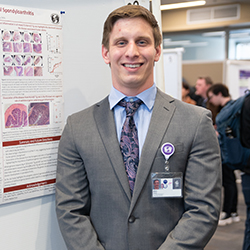
Alec Furst
Research Assistant
Division of Arthritis and Rheumatic Diseases, OHSU
Title of research: “To determine non-HLA-B27 risk genes/variants underlying axial spondyloarthritis”
Principal Investigator: Tejpal Gill, Ph.D.
Co-authors: Henry Bringenberg, John Davis, Sean Davin, Jasvinder Ahuja, Tejpal Gill
Transcript
I’m Alec Furst and I’m in the Gill Lab. And this is “Determining non-HLA-B27 risk genes and variants underlying axial spondyloarthritis.” Axial spondyloarthritis is inflammation of the spine and pelvic area, also associated with inflammation of the gut, eye and skin. We looked at HLA-B27. It’s a human gene that is associated with axial spondyloarthritis, or considered one of the main causes. We found out that HLA-B27 alone doesn’t cause disease and that there are additional genes associated with it that need to actually be inherited alongside it to produce disease. The future outcome of this work? If we can isolate these additional genes, we can target each gene for new, novel therapeutics and pre-screening techniques as well for patients. You can’t really cure it, but you can definitely treat it and make life a whole lot better; even pre-screening parents for their children, whether or not they might be predisposed to have axial spondyloarthritis.
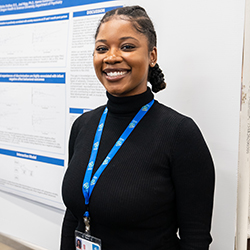
Maria Hayes
Ph.D. student
Department of Clinical Psychology, OHSU
Title of research: “Discrimination and Development: The effect of maternal adversity on child neurobehavioral development”
Principal Investigator: Elinor Sullivan, Ph.D.
Co-authors: Sridhar, N., Nigg, J.T., Gustafsson, H.C., Sullivan, E.L.
Transcript
My name is Maria Hayes, and my project is titled, “Discrimination and Development: The effect of maternal adversity on child neurobehavioral development.” In this project, I studied how different environmental factors that mothers experience — such as mental health, discrimination, social status and social support — affect child development and behavior. We learned that experiences of discrimination experienced by the mother has a very significant effect on child development and behavior. I hope the future outcome of this work will help us create more tailored intervention that help address these disparities in mother and child development and well-being.
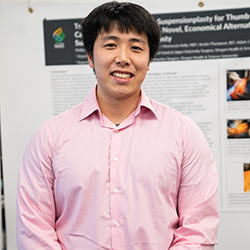
Phillip Lam, M.D., M.C.R.
Orthopaedic surgery resident
Department of Orthopaedics and Rehabilitation, OHSU
Title of research: “Trapeziectomy with Suture Suspensionplasty for Thumb Carpometacarpal Arthritis: A Novel, Economical Alternative to Suture Button Suspensionplasty”
Principal Investigator: Adam Mirarchi, M.D.
Co-authors: Matthew R. Zeiderman, Mackenzie Kelly, Austin Thompson, Adam J. Mirarchi
Transcript
I’m Phillip Lam. The title of my project is “Trapeziectomy with Suture Suspensionplasty for Thumb Carpometacarpal Arthritis: A Novel, Economical Alternative to Suture Button Suspensionplasty.” What this project is is that we came up with a new way to treat arthritis in the thumb using suture, which is essentially heavy rope that we can put inside people to suspend the thumb. What this technique offers is a new way to hold up your thumb after we take out one of the bones in your wrist that rub against your thumb bone from arthritis. So, the treatment is still the same as classically described in the past, where we take out that bone at the base of the thumb in the wrist. But, instead of filling it with like a piece of tendon or putting metal or putting plastic or using an off-the-shelf implant, we’re using a $5 piece of suture and sewing your thumb to the rest of your hand so that it is back to where it’s supposed to be and can still function like a thumb.
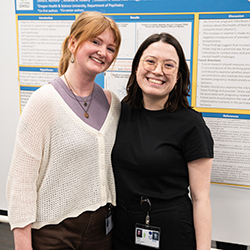
Olivia Nomura and Amanda Howery
Research staff
Prenatal Environment and Child Health (PEACH) Lab, Department of Psychiatry, OHSU School of Medicine
Title of research: “Consumption of Prenatal Vitamin C Mediates the Association between Pregnancy-Related Anxiety and Offspring Negative Affect at Six Months of Age”
Co-authors: Hanna C. Gustafsson, Elizabeth K. Wood, Elinor L. Sullivan
Transcript
I’m Olivia Nomura. I’m Amanda Howery. Our project is the “Consumption of Prenatal Vitamin C Mediates the Association between Pregnancy-Related Anxiety and Offspring Negative Affect at Six Months of Age.” So, we found that pregnant parents who are more concerned about their baby’s developing health tend to consume more vitamin C and that they also show, the infants show less negative affect, which is less negative emotions, at six months of age. These findings suggest that vitamin C intake may be a potential way for pregnant individuals to combat stress and prevent offspring mental health challenges.

Katrina Rapp
Graduate student
Department of Family Medicine, OHSU School of Medicine
Title of research: “Patient Illustration Challenge: Expanding Approaches to Patient Education via Hand-Drawn Diagrams”
Principal Investigator: Cliff Coleman, M.D., M.P.H.
Co-authors: Megha Arora, Alanna McCarthy, Keaton Weil
Transcript
My name is Katrina Rapp and this research is called the “Patient Illustration Challenge: Expanding Approaches to Patient Education via Hand-Drawn Diagrams.” Essentially, we want to help patients understand what’s going on inside of their bodies. This could help them understand why they are being prescribed a certain medication or why they’re feeling certain symptoms. What we hope happens is that medical students will increase their ability to illustrate, and their confidence illustrating, common diseases in a clinical setting to enhance a patient’s understanding of their own disease.

